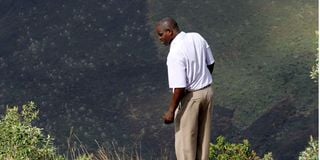Epic trip to the floor of Menengai Crater

Visitor at the Menengai Caldera View Point in Nakuru County, the world’s second largest crater; 485 metres below peak and 12km wide.
What you need to know:
Menengai Facts:
- Depth: 485m, diameter: 12 km – you’d need a whole day to walk it.
- The volcano formed about 200,000 years ago with the 12 x 8 km caldera forming 8000 years ago.
- Caldera floor is covered with numerous post caldera lava flows.
- Since 2009 the Menengai Geothermal Project, is harnessing the geo-thermal steam that has a potential of 1,600MW.
The rickety sign on a narrow murram road belies the grand caldera. A few minutes later, we’re standing on the rim of Menengai, Africa’s second largest caldera, its floor carpeted with the volcanic black obsidian. In the midst of it, pops of white vapour steam from the active earth below. It’s an amazing sight.
James Karaya of Maili Saba Camp, perched on the caldera, suggests an afternoon at the sacred caves and the viewpoint on the other side of the gigantic bowl, leaving the following day to hike to the bottom. With the wind blowing strong and the searing sun, it’s a good plan. The view from the tented room, also perched on the caldera’s edge, shows off the big bowl rimmed with jutting cliffs and high walls.
“In the old days, criminals were thrown off the cliff,” continues Karaya pointing to the sharp-pointed cliff. There is no way anyone would survive that fall.
Half an hour later, on the other side of the caldera with Lake Nakuru in the distant horizon, we’re climbing down a steep flight of rickety steps into a dark sacred cave with a towering sacred fig at the entrance. Switching on the flashlights in the dark chamber, our eyes adjust to the darkness, and we see people asleep on the dusty floor along the obsidian walls from a night of praying. “Menengai in Kikuyu language means a place of many gods,” tells Gibson, our local guide. A few buckets placed on the ground collect drops of water seeping from above.
Not wanting to disturb the sleeping pilgrims, we walk out of the cave following the streak of light from the outside. Rock hyraxes watch the humans hike past them to the top again.
Next on the list is the viewpoint with mileages to places on the map, again on the caldera’s edge. The sun begins to slide down, an ethereal sundowner in a magical place.
Day two. Energized with a hearty breakfast, the walk into the caldera takes us past the grass fields and the slaughterhouse, giving way to the shrubs and trees lining our way down. It’s hot, dusty and dry because of the drought but the wind keeps temperatures in check.
Every now and then, Harriet Matsaert stops to sketch a tree or a flower. A social anthropologist, she’s taken by the wide array of African trees compared to the few species in Europe.
Reaching out to feel the bark of a strange-looking spindly tree with a spiky crop, she’s stung by it. It turns out to be – and aptly named – the stinging nettle tree. Until now I knew of the stinging nettle as a ground plant! The leaves, despite the sting, are super medicinal for arthritis and backaches.
It’s a hike full of intrigues thanks to our tree-woman. When she stops to check out a plant with interesting shaped leaves and pink flowers, it turns out to be a Rumex sorrel plant that’s also highly medicinal with anit-fungal and anit-oxidant properties with more anti’s attached to it and used since antiquity.
At the bottom of the caldera, a giant fig tree announces a spring with cool water streaming leisurely into the ravine. “It’s like arriving at an oasis in the midst of the dry crater,” exclaims Matsaert. The men relaxing by the stream tell her the tree is an important medicinal tree for the Maasai. A closer look reveals that people have been scraping off the bark for that purpose.
The cool spring is home to a colourful Paradise flycatcher flying around, curious about the ‘new’ visitors in its home ground. Looking above, the guides point to our little lodge on the cliff and higher still, some black eagles circling against the bluest of skies.
Six kilometres with 10,000 steps clocked, we’re back at Maili Saba for another three course meal – this time, a juicy steak served with a pepper sauce, salads and fruits. The chef really knows how to feed the bone-weary hikers.
Mesmerising Menengai
160km west of Nairobi, Maili Saba Camp is run by the Ujimaa Foundation that trains disadvantaged youth in hospitality and other jobs. It is simply the best on the crater, tastefully merging in its surroundings with delicious meals served. A salon car or even a tuk-tuk from Nakuru town can take you there.
In Nakuru: Visit Lake Nakuru National Park, Sacred caves that were also used by the Mau Mau freedom fighters, View point and stop at the 5,000 –year-old Hyrax Hill Prehistoric site where our Stone Age ancestors were settling down to life as the Neolithic humans.




